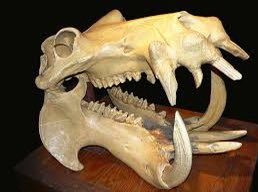Most people grew up hearing about wooly mammoths and sabre-toothed cats in some frequency throughout their childhood. These animals, and others like them, dominated the prehistoric world, and in many cases, walked right alongside early humans, though many of the most admirable creatures are forgotten and unknown by the vast majority of people. In the same lands today where the most interesting thing you might see out your window is a white tailed deer, used to be just as diverse and teeming with life as the African Savannah. However, many of these long lost marvels have close relatives alive today, and it is my hope that through this blog, I can share my fascination with these extinct animals and show their ties to modern day life on earth.
To kick off, I would like to showcase the Daeodon, or the “hell pig,” pictured below.

The daeodon was the largest member of the endeledont family, standing at roughly 6 feet tall at the shoulder, about the same size as a rhinoceros. Their heads alone were three feet long, and possessed a mixture of massive teeth and tusks which serve as evidence that it did consume meat, though it was likely an omnivore. They lived during the Miocene period, between 5-23 million years ago, in what is now the American Midwest.


These animals are classified as artiodactyls, meaning that they walk on an even number of toes, putting them alongside cows, pigs, and deer. Contrary to their nickname, however, the hell pig’s closest living relative is the hippopotamus, which shocked me when I first heard it. That leads many, including myself, to believe that instead of having all of their bony protrusions visible through the skin, as it appears in the first image, daeodon could have had a very meaty head with those bony outcrops buried in skin and muscle, as is the case with hippos as shown by image 3 above. These could also be the sites of glands used by males for chemical communication with other daeodons, which is how the warty protrusions in modern warthogs are used.
Daeodons also possessed massive neck muscles, indicated by their “hunched” back, as well as incredibly strong jaws. These characteristics are shared by modern hyenas, which are scavengers capable of biting through bone tissue and pulling immense weight with their necks. Given that they lived in a time where the American Midwest was as hostile as the grasslands of Kenya, this provides evidence that daeodon may have had a similar lifestyle to hyenas. However, it is also possible that the massive neck muscles were necessary merely to support the proportionally large head.
Scars on daeodon skulls also indicate that this species probably engaged in dominance battles that involved biting each others faces. This is a behavior seen in hippopotamus, which makes sense given their close lineage. This possibility is further supported by the ability of the daeodon to open their mouths unusually wide, which would have been an evolutionary benefit in both feeding as well as fights against other males.
The rest of the daedon body consists of a stocky torso and thin legs, which I think looks a lot like the American Bison of today. I find this interesting that these two animals lived in the same habitat and have such a similar torso and legs, so maybe that means that this is just an effective body shape for moving long distances across the plains.
Beyond this, not much is known about the daeodon. But, I think that this segment exemplified the goal of my blog, which is just to explore an animal that is not well known, and see how we can uncover how it used to live by placing it among animals of today. Additionally, I hope that you will think about the plains of Kansas slightly differently now with the knowledge that there used to be giant, meat-eating hell pigs scavenging there.
References:
“Entelodont.” Encyclopædia Britannica, Encyclopædia Britannica, Inc., https://www.britannica.com/animal/entelodont.
Strauss, Bob. “Daeodon, Formerly Known as Dinohyus, the Terrible Pig.” ThoughtCo, ThoughtCo, 16 Jan. 2020, https://www.thoughtco.com/daeodon-dinohyus-terrible-pig-1093187.